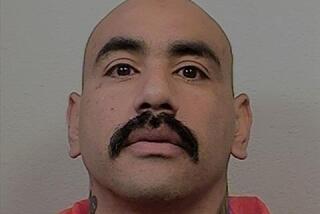Cesar Romero, Suave Star for Over 60 Years, Dies at 86 : Hollywood: The actorâs career spanned stage, films and TV. He remained socially prominent in retirement.
Cesar Romero, the classically handsome, debonair Latin Lothario of stage, film and television for nearly seven decades and an omnipresence on the Hollywood social circuit long after he had given up acting, has died. He was 86.
Romero died Saturday night at St. Johns Hospital and Health Center in Santa Monica, according to hospital spokesman Gary Miereanu. Romero, who had been hospitalized with severe bronchitis and pneumonia, died of complications of a blood clot, the spokesman said.
To younger audiences, the enduring and versatile Romero was most familiar as the Joker in the television series âBatmanâ in the mid-1960s and opposite Jane Wyman as matriarch Angela Channingâs husband, Peter Stavros, on âFalcon Crestâ from 1985 to 1987.
Although he began on Broadway, Romero was probably better known for the dozen or so musical comedy films he made for 20th Century Fox in the 1930s to 1950s opposite such stars as Alice Faye and Betty Grable, and for his role as the Cisco Kid in a series of films.
Romero began his career as a nightclub dancer, and throughout his life was regarded as Hollywoodâs most desirable dancing partner at parties as well as on stage or screen.
âWe had plenty of clothes and no money,â he once told The Times, explaining how he became an elegant gate-crasher in order to enjoy dinner dances and Broadway theater as a young man in New York.
Romero was born there, the son of machinery exporter Cesar Julio Romero and singer Maria Mantilla, and liked to refer to himself as âa Latin from Manhattan.â
âIf his business hadnât gone broke, Iâd be exporting nuts, bolts and sugar machinery right now,â he told The Times in 1965. âWhat an awful thought!â
Romeroâs maternal grandfather was Jose Marti, the Cuban patriot and martyr for whom Havanaâs airport is named. The entertainer was the guest of honor in 1965 when New York unveiled its Central Park statue of Marti.
Romero, a lifelong bachelor, segued easily from stage to screen to television to dinner theater and private dinner parties partially because of his perennial good looks. In 1965, The Timesâ now-retired arts editor, Charles Champlin, observed that âMr. Romero seems to have access to the same anti-age potion as Cary Grant.â
Active until quite recently, Romero helped serve Thanksgiving dinners to the homeless at the Los Angeles Mission on Skid Row and was on the celebrity guest list for the opening night of Andrew Lloyd Webberâs âSunset Boulevardâ Dec. 9.
âIâm 86 and my doctor used to tell me to slow down--at least he did until he dropped dead,â Romero quipped to a Toronto newspaper last summer. âBut we Latins make splendid lovers and splendid older men.
âI canât date women my own age any more--I hate going to cemeteries,â he joked. âSo I look for the younger breed. I take them dining and dancing and by the end of an evening theyâre bushwhacked, whereas I still want to go on to the next nightclub.â
Contrary to Romeroâs suave image, his Hollywood friends and his family usually called him Butch.
âGeorge Murphy tagged that name on me years ago,â he explained. âWe were all at a party and he went around tagging names on people that didnât fit them. I was tall and skinny and had black hair and played gigolos and he said: âYour name is Butch.â Everyone laughed and it stuck.â
Romero made his stage debut as a dancer in the 1927 New York show âLady Do,â and his Broadway debut as Ricci in the 1932 play âDinner at Eight,â which ran for more than 300 performances.
Other plays included âStella Brady,â âAll Points West,â âSpring in Autumn,â âTen Minute Alibiâ and âMr. Barryâs Etchings.â He toured as the Count di Ruvo in âStrictly Dishonorable.â
Moving to Hollywood, Romero made his film debut as Jorgensen in âThe Thin Manâ in 1934. Other early films in the 1930s included âBritish Agent,â âShow Them No Mercy,â âMetropolitan,â âLove Before Breakfast,â âWee Willie Winkie,â âHappy Landing,â âMy Lucky Star,â the Cisco Kid series and âThe Gay Caballero.â
In his mid-30s when World War II broke out, Romero interrupted his long string of films for three years service in the U.S. Coast Guard.
âIâm satisfied to go in at the bottom--thatâs the best way to learn what things are all about,â he said when he enlisted at the Long Beach office.
Romero became a chief boatswainâs mate, the highest noncommissioned rank in the service, equivalent to a master sergeant. He frequently served as a public spokesman, urging U.S. workers to increase production and support for the soldiers and sailors he helped to transport.
After the war, he resumed his light comedy roles with âCarnival in Costa Rica,â âCaptain From Castille,â âThat Lady in Ermineâ and âDeep Waters.â
During the 1950s, he made such films as âHappy Go Lovely,â âLost Continent,â âPrisoners of the Casbah,â âThe Americanoâ and the classic âAround the World in 80 Days.â
His film career continued well into the 1960s with such films as âOceanâs Eleven,â âThe Castilian,â âSergeant Deadheadâ and âMarriage on the Rocks.â
But in the 1950s and 1960s, Romero also became a popular guest on various television series. Along with âBatman,â he was the urbane, mysterious foreign courier in the series âPassport to Danger,â and appeared frequently in variety series such as the Milton Berle, Martha Raye, Dinah Shore, Betty Hutton, Red Skelton and Jimmy Stewart shows.
He also played guest roles in drama series such as âThe Zane Grey Theatreâ and âPlayhouse 90â and in Westerns such as âWagon Trainâ and âStage Coach West.â Younger audiences also will remember him from âIronside,â âFantasy Islandâ and âThe Love Boat.â
For a brief time in 1972, Romero ran a restaurant in Los Angeles called Cappucino.
He also became a popular actor and dancer on the dinner theater circuit in the 1970s and â80s, appearing in such plays as âMy Three Angels,â âGoodbye, Tiger, Goodbye Fifi,â âA Dash of Spiritsâ and âThe Max Factor.â
Pragmatically always finding the medium that could use him, Romero never tried to resurrect his original career as a nightclub dancer.
âI donât dance (professionally) anymore,â he said in the 1960s. âIâm getting too old for that kind of stuff.
âOut of shape, oh, brother,â he said after one dance act in Las Vegas. âI was wearing corn plasters above and below my toes and taping my ankles twice.â
Romero was one of the first Hollywood actors to demand a percentage of profits in payment for his film roles.
In 1984, in honor of his 50th year in films, he received the career achievement award at the Hollywood International Celebrity Awards Banquet. That same year he earned a Nosotros Golden Eagle award for his success as a Latino in the entertainment industry.
In 1991, the octogenarian accepted the Imagen Hispanic Media award for lifetime achievement. In 1992, the Beverly Hills Chamber of Commerce gave him its Will Rogers Memorial award.
Romero lived and performed long enough to feel like something of an anachronism. In 1965, he told The Timesâ Champlin how Hollywood had changed in the 30 years he had gone from studio contract player to forced free-lancer:
âItâs a new town. The old elegance is gone. It used to be one big family, this industry.
âYou knew everybody at all the studios and you saw them often,â he said. âEvery Sunday night youâd be at the Trocadero for the show and youâd know everybody. No tourists, no gawkers. Now I donât know half of the young people in the industry. Itâs too spread out, too diffuse.
âSometimes,â he mused, âI wonder what Iâm doing here.â
Romero is survived by his brother, Eduardo, three nieces, one nephew and three great nephews.
Funeral services will be private. The family has asked that any memorial donations be made to the Arthritis Foundation.
More to Read
The biggest entertainment stories
Get our big stories about Hollywood, film, television, music, arts, culture and more right in your inbox as soon as they publish.
You may occasionally receive promotional content from the Los Angeles Times.










